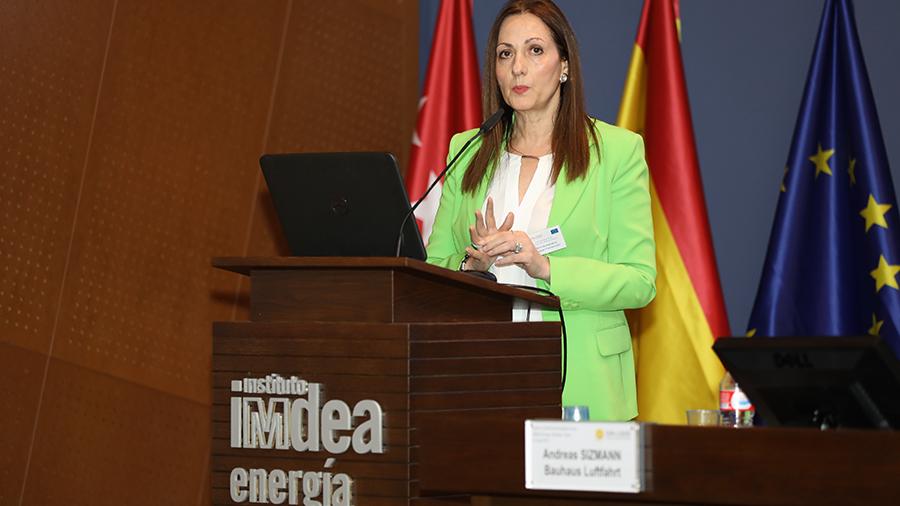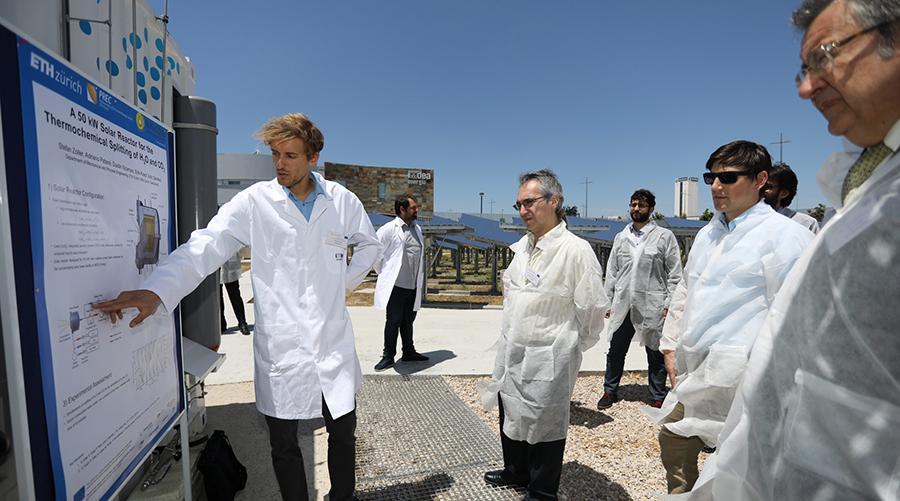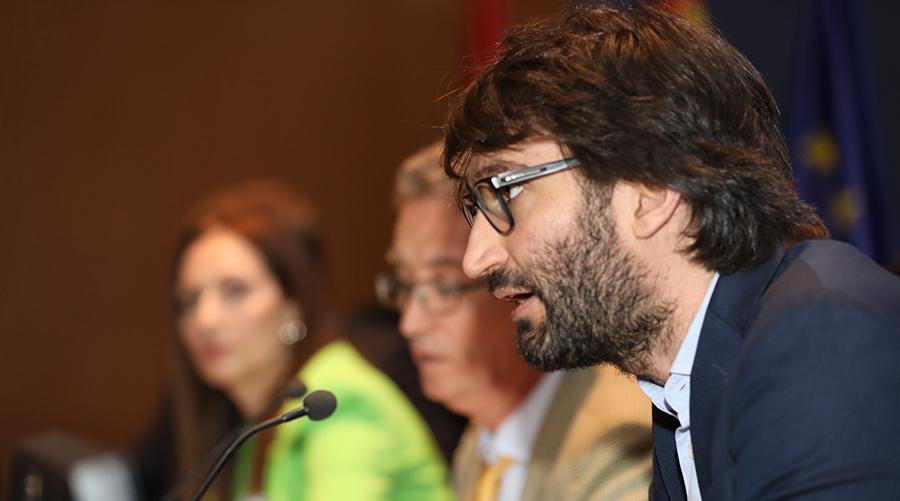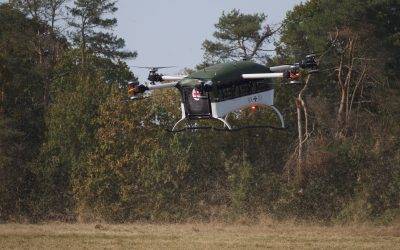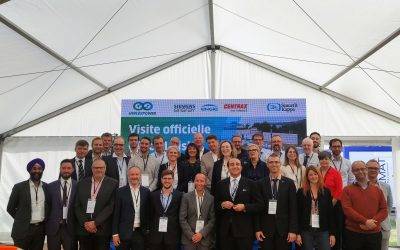SUN-to-LIQUID Demonstration Event
Over the last 3.5 years, the SUN-to-LIQUID project has built a unique research facility to demonstrate the thermochemical synthesis of liquid hydrocarbon fuels from water, carbon dioxide and high-flux solar radiation. To showcase this achievement, the SUN-to-LIQUID demonstration event was organized at the solar fuel plant at IMDEA Energy Institute, Móstoles, Madrid, Spain.
The SUN-to-LIQUID partners proudly presented the research facility and outlined the importance of the project’s innovations for science, industry and society. A concluding panel discussion with key stakeholders further illuminated the progress and prospects of solar fuels.
Solar kerosene from sunlight, water and CO2
The transition from fossil to renewable fuels is one of the most important challenges of the future. The SUN-to-LIQUID project addresses this challenge by producing renewable transport fuels from water and CO2 using concentrated sunlight: The project, funded by the EU and Switzerland, has now succeeded in demonstrating the first synthesis of solar kerosene. “The SUN-to-LIQUID core solar technology and the integrated chemical system were experimentally validated under real field conditions relevant for industrial implementation,” says Prof. Aldo Steinfeld of ETH Zurich, who is leading the development of the solar thermochemical reactor. “This technological demonstration can have important implications for the transportation sector, particularly for long-haul aviation and shipping, which rely heavily on drop-in hydrocarbon fuels,” announced project coordinator Dr. Andreas Sizmann of Bauhaus Luftfahrt, “We are now one step closer to living on a renewable ‘energy income’ instead of burning our fossil ‘energy legacy’. This is a necessary step to protect our environment.”
From the laboratory to the field
The previous EU project SOLAR-JET developed the technology and achieved the first ever production of solar jet fuel in a laboratory environment. The SUN-to-LIQUID project scaled up this technology for testing on a solar tower on the sun. For this purpose, a unique solar concentration plant was built at the IMDEA Energy Institute in Móstoles, Spain. “An array of heliostats tracking the sun concentrates sunlight by a factor of 2,500 – three times higher than current solar tower systems used to generate electricity,” explains Dr. Manuel Romero of IMDEA Energy. This intense solar flux, verified by the flux measurement system developed by project partner DLR, allows reaction temperatures of more than 1,500°C to be reached within the solar reactor, which is located at the top of the tower. The solar reactor developed by the project partner ETH Zurich produces synthesis gas, a mixture of hydrogen and carbon monoxide, from water and CO2 via a thermochemical redox cycle. An on-site gas-to-liquid plant developed by project partner HyGear processes this gas into kerosene.
Compared to conventional jet fuel derived from fossil fuels, net CO2 emissions to the atmosphere can be reduced by more than 90%. Moreover, because the solar-powered process uses abundant feedstocks and does not compete with food production, it can meet future fuel needs on a global scale without having to replace existing global fuel distribution, storage, and use infrastructure.
Project background
SUN-to-LIQUID is a four-year project supported by the European Union’s Horizon 2020 research and innovation programme and the Swiss State Secretariat for Education, Research and Innovation (SERI). It started in January 2016 and will end on December 31, 2019. Leading European research organisations and companies in the field of solar thermochemical fuel research are participating in SUN-to-LIQUID, namely ETH Zurich, IMDEA Energy, DLR, Abengoa and HyGear Technology & Services B.V. The coordinator Bauhaus Luftfahrt e.V. is also responsible for technology and system analyses. ARTTIC supports the research consortium with project management and communication.
SUN-to-LIQUID website
SUN-to-LIQUID project video
SUN-to-LIQUID flyer
SUN-to-LIQUID press photo
The R&D tax credit with a blind eye to earnings –
Why loss-making companies (wrongly) hesitate
Recapitulation The German R&D tax credit has become much more popular in recent years after a modest response following the introduction of the instrument. This can be seen not only in advertising and studies by various associations, but also in the bare figures...
iMEDCAP: European project to pioneer the rescue of wounded soldiers from inaccessible areas
iMEDCAP: How an innovative European project shall pioneer the rescue of wounded soldiers from inaccessible areasIn December, the project iMEDCAP, funded by the European Defence Fund, was kicked-off. With its user-driven, holistic approach, the flagship iMEDCAP sets...
Junior Funding Consultant (m/f/d)
We offer you the unique opportunity to become part of a successful & young team in the attractive growth market for tax-incentivised research funding (R&D tax credits). We are looking for Junior Funding Consultants with a passion for innovation, scientific...
First successful demonstration with 100% green H2
HYFLEXPOWER celebrates successful operation of a gas turbine with 100% green H2On October 12, 2023, at a public event hosted at the HYFLEXPOWER demonstrator site in Saillat-sur-Vienne, France, the HYFLEXPOWER consortium unveiled a ground-breaking achievement - the...
New Security Project AGILE Will Improve Disaster Risk Management
New international security project to improve disaster risk management for unexpected eventsThe international security project AGILE will kick start today. The project is to develop novel tools and methodologies for understanding, anticipating, and managing High...
How the government’s draft of the Growth Opportunities Act refines the research allowance
Government draft of the Growth Opportunities ActThe government draft of the submitted Growth Opportunities Act has once again undergone a significant redesign compared to the draft bill (§ 33 from p. 71). The revision regarding the Research Grants Act rewards small...
SYNERGISE for Improved Disaster Management
Internationally Funded Project to Develop an Integrated Toolkit for Improved Management of Natural and Man-Made Disasters Kicks-Off TodayTo boost the efficiency and safety of first responders during life-saving missions, the SYNERGISE team will develop a Novel...
Junior Innovation Consultant (m/f/d)
We offer you the unique opportunity to become part of a dynamic team in the attractive field of innovation and research. We are looking for Innovation Consultants with a passion for innovation, scientific writing and project management. This position is for recent...
Senior Innovation Consultant (m/f/d)
We offer you the unique opportunity to become part of a dynamic team in the attractive field of innovation and research. We are looking for specialists with a passion for innovation, scientific writing and project management. This position is for experienced...
Business Developer (m/f/d)
We are looking for specialists in business development with a strong sales talent and an interest in innovation, research and science. This position is for recent graduates or experienced professionals and involves assisting clients from a variety of industries with...
